NMR Data Acquisition The process of data acquisition results in an ...
NMR Data Acquisition The process of data acquisition results in an ...
NMR Data Acquisition The process of data acquisition results in an ...
You also want an ePaper? Increase the reach of your titles
YUMPU automatically turns print PDFs into web optimized ePapers that Google loves.
Figure 9. Relative to the reference frequency<br />
(center <strong>of</strong> the spectral w<strong>in</strong>dow) the nuclei c<strong>an</strong><br />
rotate either clockwise or counter-clockwise <strong>in</strong><br />
the rotat<strong>in</strong>g frame <strong>of</strong> reference. Imag<strong>in</strong>e that we<br />
have a detector mounted on the x <strong>an</strong>d y axes,<br />
<strong>an</strong>d each time the magnet <strong>of</strong> the sample nuclei<br />
passes a detector it gives a "blip" from that<br />
detector. Clockwise rotation would give a<br />
pattern <strong>of</strong> blips where the y signal leads the x<br />
signal, while counter-clockwise rotation leads to<br />
a situation where the y signals lags beh<strong>in</strong>d the x<br />
signal. This is sufficient <strong>in</strong>formation to tell the<br />
direction <strong>of</strong> rotation, which is equivalent to the<br />
sign <strong>of</strong> the signal frequency. Thus the r<strong>an</strong>ge <strong>of</strong><br />
detectable frequencies is from -SW/2 to +SW/2.<br />
frequency scale <strong>in</strong> the center <strong>of</strong> the<br />
spectral w<strong>in</strong>dow requires that we have a<br />
way to tell the difference between<br />
positive frequencies <strong>an</strong>d negative<br />
frequencies. This is accomplished by<br />
us<strong>in</strong>g a technique called quadrature<br />
detection. <strong>The</strong> radio frequency FID<br />
signal is mixed with two different<br />
reference RF signals, one <strong>of</strong> which is<br />
shifted by 90 o (one-fourth <strong>of</strong> a cycle) <strong>in</strong> phase with respect to the other (Fig. 6). <strong>The</strong> difference<br />
frequency is selected <strong>in</strong> both cases, result<strong>in</strong>g <strong>in</strong> two audio signals which are 90 o out <strong>of</strong> phase with<br />
each other. <strong>The</strong>se signals are traditionally called the “real” <strong>an</strong>d the “imag<strong>in</strong>ary” FIDs, but there<br />
is noth<strong>in</strong>g more or less real about either one. <strong>The</strong> best way to th<strong>in</strong>k about these “stereo” signals<br />
is to imag<strong>in</strong>e that there are two coils <strong>in</strong> the spectrometer: one placed on the x axis <strong>of</strong> the rotat<strong>in</strong>g<br />
frame <strong>an</strong>d one placed on the y axis <strong>of</strong> the rotat<strong>in</strong>g frame. If the magnetization result<strong>in</strong>g from a<br />
type <strong>of</strong> nucleus <strong>in</strong> the sample is rotat<strong>in</strong>g clockwise <strong>in</strong> the rotat<strong>in</strong>g frame, it will generate a signal<br />
<strong>in</strong> the y-axis detector just before it hits the x-axis detector, so that the “imag<strong>in</strong>ary” (y-axis) signal<br />
will lag beh<strong>in</strong>d the “real” (x-axis) signal by 90 o (Figure 9). We c<strong>an</strong> thus determ<strong>in</strong>e that this<br />
frequency is a negative audio frequency, <strong>an</strong>d place the peak <strong>in</strong> the spectrum <strong>in</strong> the upfield half <strong>of</strong><br />
the spectral w<strong>in</strong>dow. Imag<strong>in</strong>e a carrousel with one person rid<strong>in</strong>g on it near the edge. If you have<br />
two observers, one on the north side <strong>an</strong>d one on the east side, <strong>an</strong>d each observer calls out the<br />
direction as the rider goes by, you c<strong>an</strong> tell which way the carrousel is rotat<strong>in</strong>g because you would<br />
hear “North East ... ... North East ... ...” for the clockwise direction <strong>an</strong>d “East North ...<br />
... East North ... ...” for the counter-clockwise direction. With only one observer you would<br />
hear, for example, “North ... ... ... North ... ... ...” <strong>an</strong>d you would not be able to tell which<br />
direction the carrousel is rotat<strong>in</strong>g. <strong>The</strong> direction <strong>of</strong> rotation <strong>of</strong> the carrousel is <strong>an</strong>alogous to the<br />
sign <strong>of</strong> the frequency <strong>of</strong> <strong>an</strong> <strong>NMR</strong> peak <strong>in</strong> your spectrum. If we only had one “detector”, which is<br />
the equivalent <strong>of</strong> hav<strong>in</strong>g only one FID ch<strong>an</strong>nel, we could not dist<strong>in</strong>guish between positive <strong>an</strong>d<br />
negative audio frequencies.<br />
25



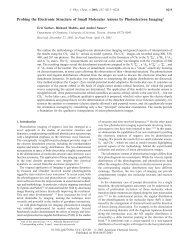

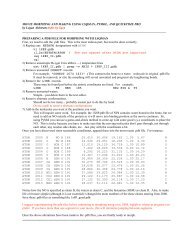


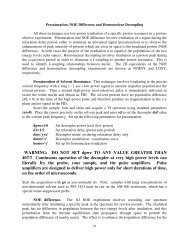


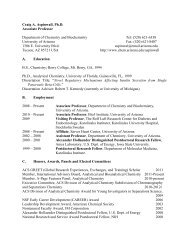
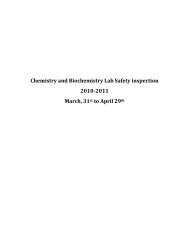
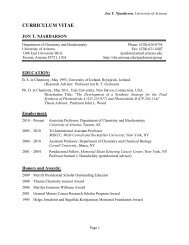
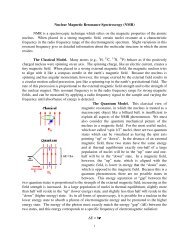
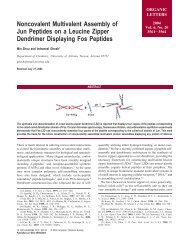
![Program [pdf] - Department of Biochemistry and Molecular ...](https://img.yumpu.com/8309921/1/167x260/program-pdf-department-of-biochemistry-and-molecular-.jpg?quality=85)